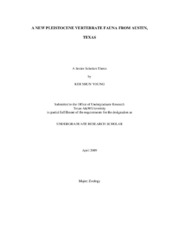| dc.description.abstract | A new fossil vertebrate fauna consisting of fish, snake, and small mammalian remains was discovered near McKinney Falls State Park in Austin, Texas. Identification and analysis of the species in the cave deposit reveals paleoclimatic and paleoenvironmental changes between the late Pleistocene (over 11,500 years ago) and the present. This site is unique in the very large number of snake fossils (422 skeletal elements) compared to the mammalian fossils (79 skeletal elements) collected. This makes the site a prime candidate for the first fossil multispecies snake hibernaculum ever found in the world. Hibernacula are places in which large groups of animals, including snakes, gather to spend the winters in hibernation. Identification of the snake species is based on the morphology of the trunk vertebrae, and the fossils currently are identified as racers (Coluber constrictor or Masticophis sp.), garter snakes (Thamnophis sp.) or water snakes (Nerodia sp.) and Baird’s rat snake (Elaphe bairdi). Those snakes commonly form multispecies hibernacula in shelters today. However, snakes do not form multispecies hibernacula in Central Texas today, but only in more northern colder regions. Identification of the mammalian fauna of the site is primarily based on morphology of teeth, and the fossil teeth are harvest mice (Reithrodontomys sp.), voles (Microtus sp.), southern bog lemmings (Synaptomys cooperi), pocket gophers (Geomys sp.), black-tailed jackrabbit (Lepus californicus), shrews (Notiosorex sp. or Sorex sp.), and a bat. All of these mammalian taxa also have been found in other Pleistocene sites around Austin and across central Texas. However, some of the mammalian species in this cave deposit do not occur in Texas after the end of the Pleistocene and are currently located in the eastern and northern regions of North America. The changes in the geographic distribution of mammals and the inferred changes in snake behavior in this cave likely are biological response to the shift to warmer climates in Central Texas since the end of the Pleistocene. | en |


